This article needs additional citations for verification .(February 2024) |

The Gibson L5S is a solid-body electric guitar model produced by the Gibson Guitar Corporation. [1] [2]
This article needs additional citations for verification .(February 2024) |

The Gibson L5S is a solid-body electric guitar model produced by the Gibson Guitar Corporation. [1] [2]
Introduced in 1972, the Gibson L5S was essentially a smaller, thinner solid-body version of the popular Gibson L-5 hollowbody. Like the L-5, it featured multiple binding on the single-cutaway 3-ply solid maple body, 5-piece maple neck, and headstock, and also featured an ebony fingerboard with block inlays. The headstock featured a flower-pot inlay similar to the L-5 archtop and most L5S models featured the L-5 trapeze tailpiece (though some had stop-bar or TP-6 fine-tuning tailpieces). The L5S was available in various finishes, such as ebony, cherry sunburst, wine red and natural.
Upon its introduction in 1972, the L5S featured two low-impedance pickups, similar to those found on several Gibson Les Paul models of that period, such as the Recording model, the Signature model, the Personal model, and the Professional model. This incarnation of the model was not a success, however, thus Gibson switched from low-impedance pickups to regular [[humbucker] Super Humbucking Tarback pickups, which were designed by Bill Lawrance.]. Though it was considered one of Gibson's more top-of-the-line models, it was still not particularly popular among guitarists. In the mid-1980s, the L5S was dropped from the Gibson line. L5-S guitars were produced with a one-piece top and back (very rare), two-piece top and back (also quite rare). The Norlin era in the production of Gibson guitars did not pass over the L5-S model, and that is why guitars with a three-piece top and back are the most common. [probably they were saving on materials and that's why they started gluing tops from three pieces]. Today, the L5-S is sought after by collectors and blues and jazz musicians, the sound of the L5-S is clear and warm. They work great with different types of music. Today it is extremely difficult to find a guitar with the original [Tarback] pickups. Only 1,813 units were produced, according to Gibson.
The L5S was a unique high-end solid body, and once Gibson adorned it with super humbuckers, famous guitarists took notice, especially jazz and fusion virtuosos like Pat Martino and John McLaughlin. Additionally other players picked up the L5S such as Paul Simon and others including possibly Keith Richards at one time. Ronnie Wood has been seen playing a new incarnation of the Gibson L5S which is currently a signature model in production, the 'Ronnie Wood L-5S'as well as Mark Farner from Grand Funk.
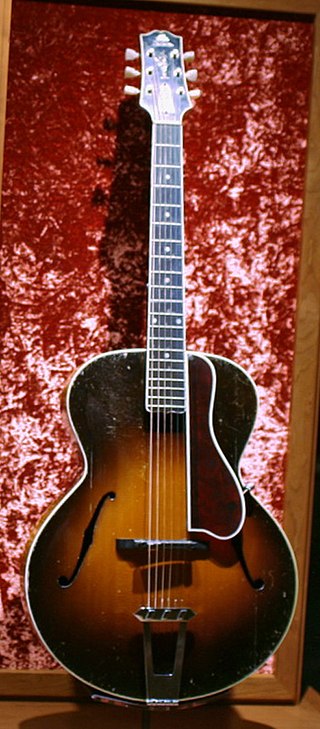
The Gibson L-5 is a hollow body semi-acoustic guitar first produced in 1923 by the Gibson Guitar Corporation, then of Kalamazoo, Michigan. The first guitar to feature F-holes, the L-5 was designed under the direction of acoustical engineer and designer Lloyd Loar, and has been in production ever since. It was considered the premier guitar of the company during the big band era. It was originally offered as an acoustic instrument, with electric models not made available until the 1940s.

The Gibson Les Paul is a solid body electric guitar that was first sold by the Gibson Guitar Corporation in 1952. The guitar was designed by factory manager John Huis and his team with input from and endorsement by guitarist Les Paul. Its typical design features a solid mahogany body with a carved maple top and a single cutaway, a mahogany set-in neck with a rosewood fretboard, two pickups with independent volume and tone controls, and a stoptail bridge, although variants exist.
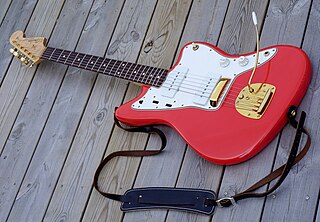
The Fender Jazzmaster is an electric guitar designed as a more expensive sibling of the Fender Stratocaster. First introduced at the 1958 NAMM Convention, it was initially marketed to jazz guitarists, but found favor among surf rock guitarists in the early 1960s. Its appearance is similar to the Jaguar, though it is tonally and physically different in many technical ways, including pickup design, scale length and controls.

The Gibson ES-335 is a semi-hollow body semi-acoustic guitar introduced by the Gibson Guitar Corporation as part of its ES series in 1958. It features a solid maple wood block running through the center of its body with upper bouts that are hollow and two violin-style f-holes cut into the top over the hollow chambers. Since its release, Gibson has released numerous variations of and other models based on the design of the ES-335.
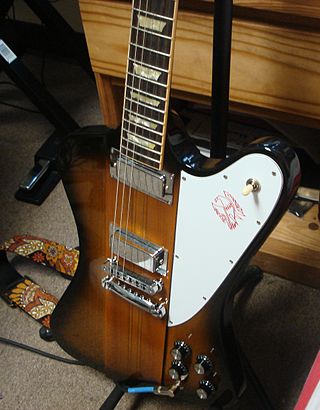
The Gibson Firebird is a solid-body electric guitar manufactured by Gibson beginning in 1963.
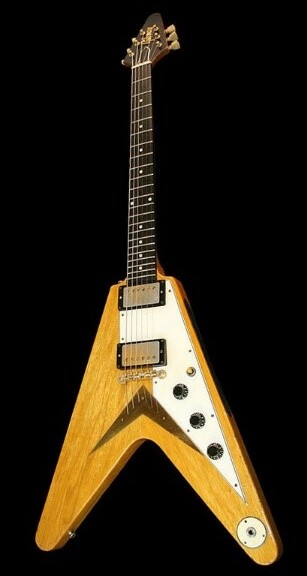
The Gibson Flying V is an electric guitar model introduced by Gibson in 1958. The Flying V offered a radical, "futuristic" body design, much like its siblings: the Explorer, which was released the same year, and the Moderne, which was designed in 1957 but not released until 1982. The initial run of guitars used a distinctive wood of the Limba tree marketed by Gibson under the trade name "korina"; later models used more conventional woods.

The Gibson Explorer is a type of electric guitar model by Gibson guitars, released in 1958. The Explorer offered a radical, "futuristic" body design, much like its siblings: the Flying V, which was released the same year, and the Moderne, which was designed in 1957 but not released until 1982. The Explorer was the final development of a prototype design that, years later, Gibson marketed under the name Futura.

The G-400 is an Epiphone solid body electric guitar model produced as a more modestly priced version of the famous Gibson SG. Currently, Epiphone is a subsidiary of Gibson and manufactures the G-400 and other budget models at a lower cost in Asia. Visually and ergonomically, it is almost identical to a 1962 SG.

The Jackson Dinky is a Superstrat-style double-cutaway electric guitar built by Jackson Guitars. The "Dinky" is named for its slightly smaller than normal (7/8) body size. Usually fitted with a two humbucker pickup configuration, some models also include single-coil pickups and/or just one bridge humbucker. The fretboard can be made out of ebony, rosewood and more recently maple, or rock maple, with 24 jumbo frets and is always built with a bolt-on neck. Most of the guitars have a Floyd Rose original or licensed tremolo, and a locking nut to help maintain stable tuning. Some Dinkys have hardtail, or String-Thru bridges. The Jackson Dinky is usually preferred by players of hard rock and heavy metal.
The Gibson Melody Maker is an electric guitar made by Gibson Guitar Corporation. It has had many body shape variations since its conception in 1959.
The Jackson Rhoads is a model of electric guitar, originally commissioned by guitarist Randy Rhoads and produced by Jackson Guitars.
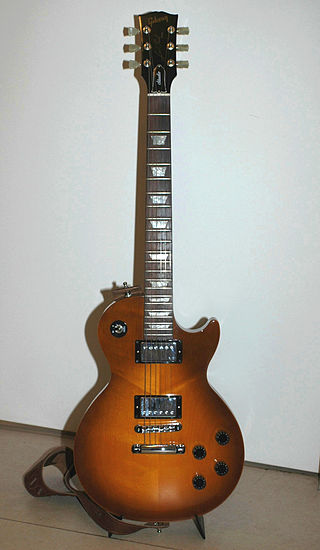
The Gibson Les Paul Studio is a solid body electric guitar produced by the Gibson Guitar Corporation since 1983. It is a model of Les Paul with some features omitted to appeal to musicians looking for the tonal qualities of the guitar but with less of an emphasis on cosmetics and to reduce the price of the instrument.

The Gibson L6-S is a solid body electric guitar. It was the descendant of the L5S jazz solid-body electric guitar. It was the same shape, very much like a wide Gibson Les Paul, but with a 24-fret neck, the first Gibson guitar to have this.

The Gibson Nighthawk was a family of electric guitars manufactured by Gibson. Introduced in 1993, the Nighthawk represented a radical change from traditional Gibson designs. While its maple-capped mahogany body and set neck were reminiscent of the classic Gibson Les Paul, the Nighthawk incorporated a number of characteristics more commonly associated with Fender guitars. The Nighthawk was not a commercial success; production of all models was discontinued in 1998 after only five years.
The Gibson ES series of semi-acoustic guitars are manufactured by the Gibson Guitar Corporation.
The Epiphone Sheraton is a thinline semi-hollow body electric guitar. Though the Sheraton and all its variations were introduced under the ownership of the Gibson Guitar Corporation, Epiphone is the exclusive manufacturer.

Duesenberg is a brand for electric string instruments founded in 1986 and located in Hannover, Germany. The headquarter is in Hannover, Germany, they are known for using a Plek machine for the levelling of frets and setup. Duesenberg has uploaded a factory production video of how their guitars are made, revealing that most of the production of the guitars is done in Croatia, while the final setup and assembly is done in Germany.

The Gibson ES-333 is a semi hollow body electric guitar made by Gibson Guitar Corporation.

The Gibson ES-165 Herb Ellis is an Archtop guitar manufactured by the Gibson Guitar Corporation in Nashville Tennessee. By March 2013, it was no longer in production.

The Peavey EVH Wolfgang guitar series is a collaboration between guitarist Eddie Van Halen and Hartley Peavey's company, Peavey Electronics. The EVH stands for "Eddie Van Halen" while Wolfgang is the name of Eddie Van Halen's son.